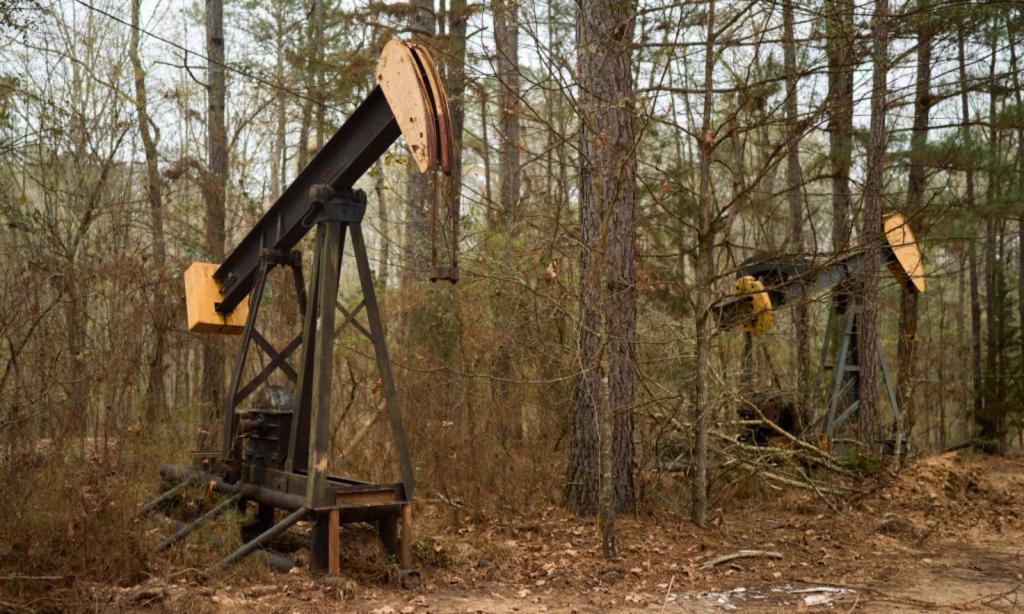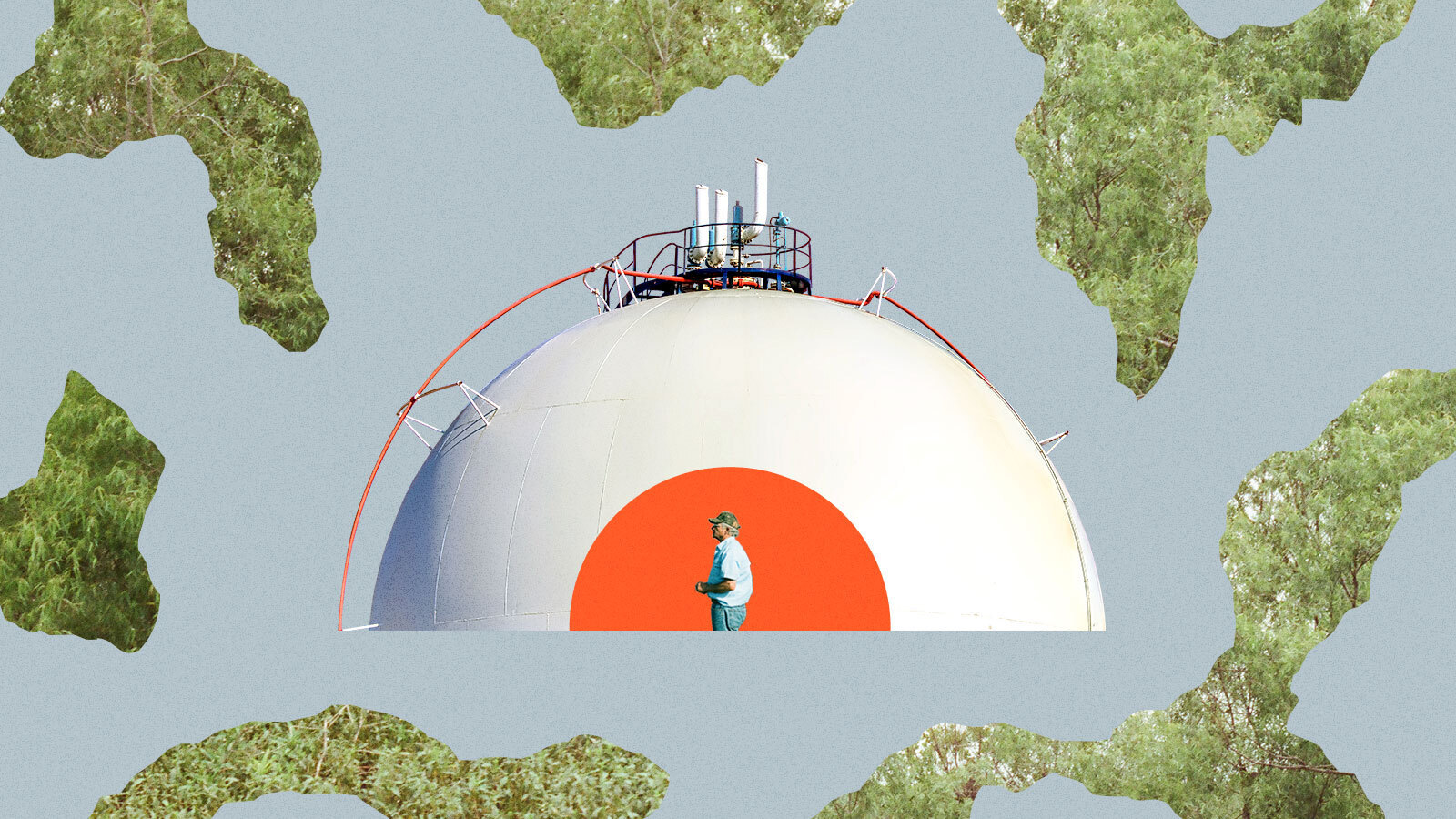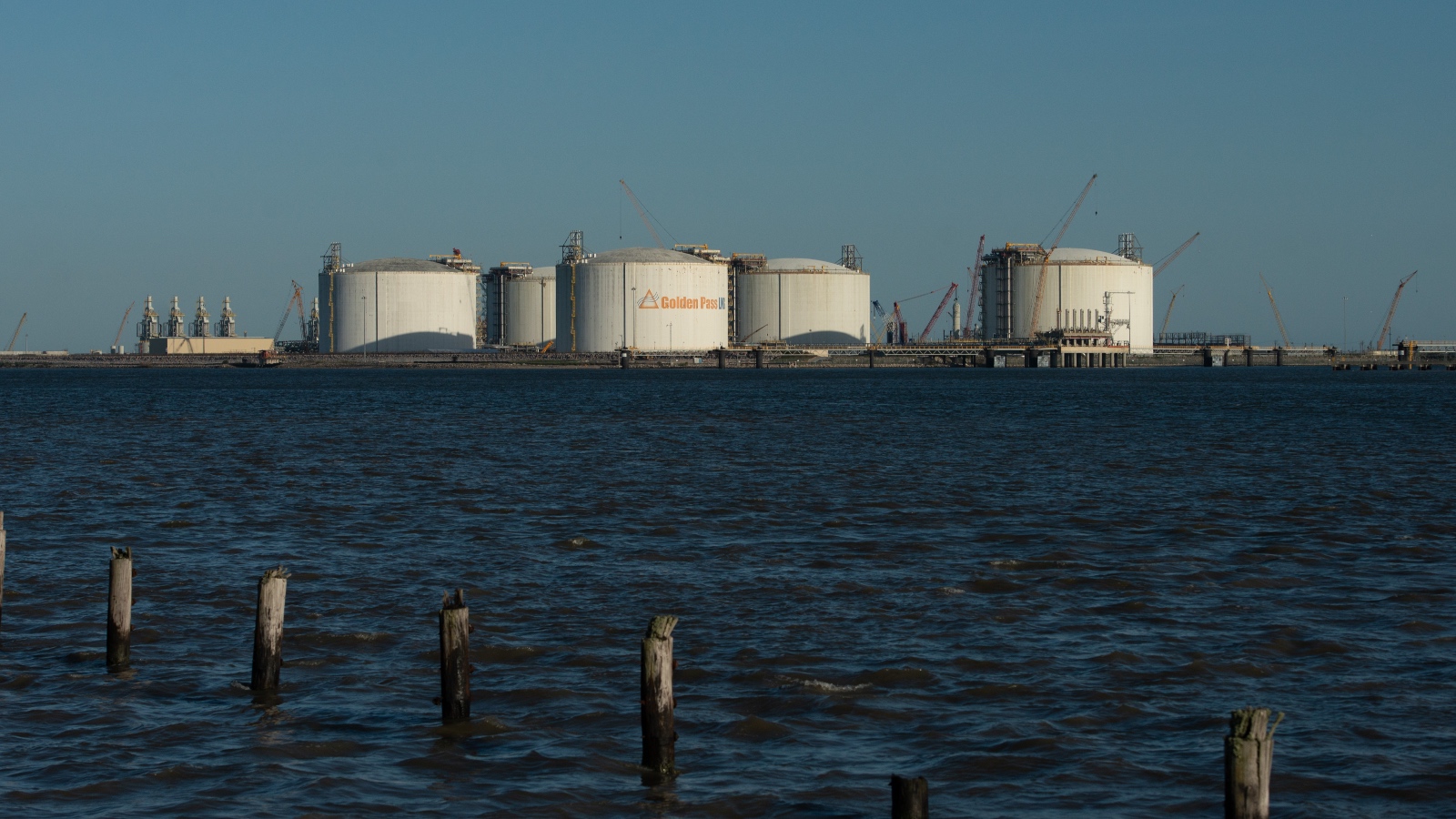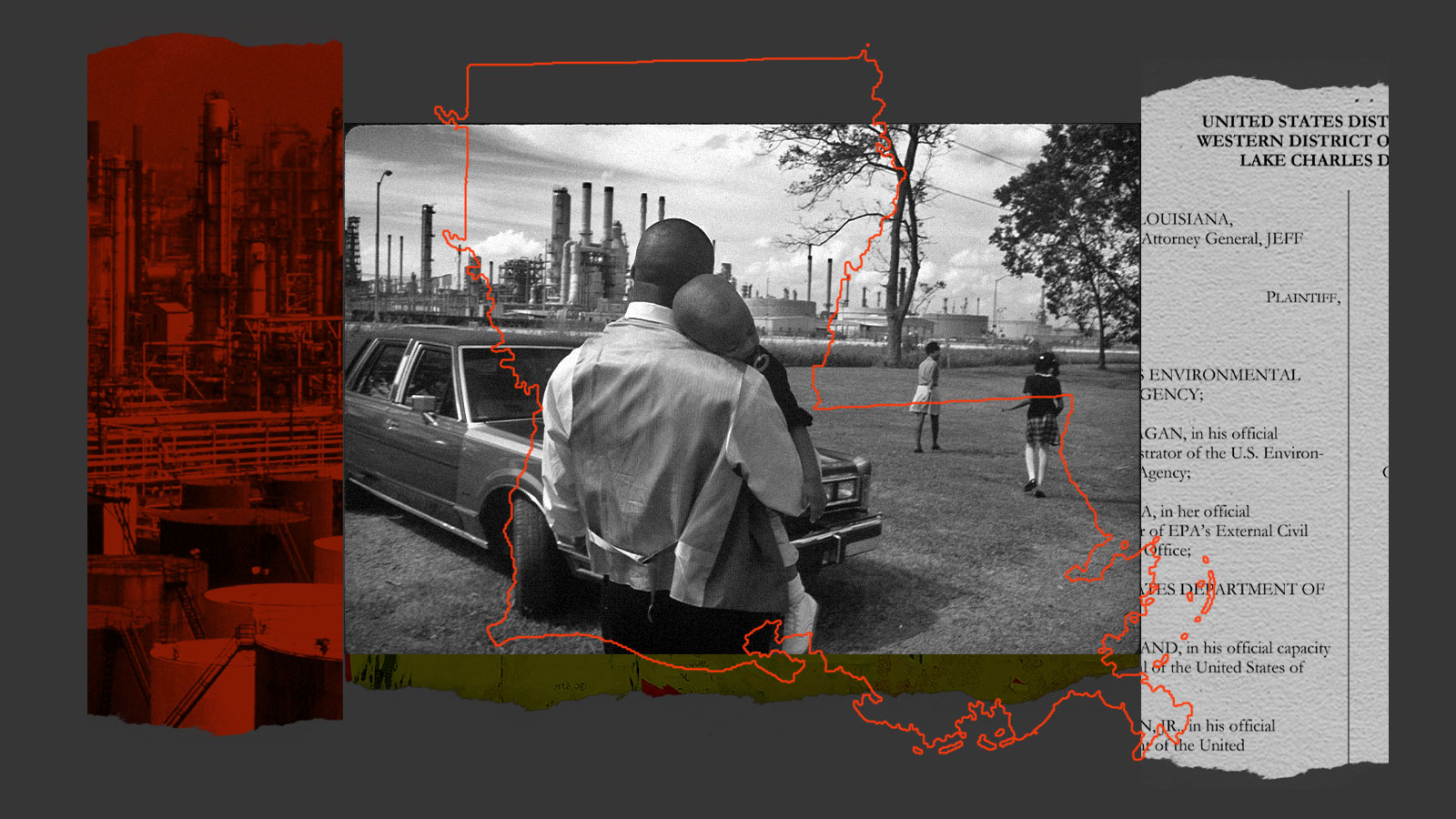This story was co-published with The Lens.
To visit the country’s newest hub for exporting liquefied gas to Europe, follow the Mississippi River southeast from New Orleans, past the recently shuttered Phillips 66 refinery in Alliance and deeper into Plaquemines Parish, a ribbon of land that flanks the lower Mississippi River before dropping off into the Gulf of Mexico. There, strip malls and highways give way to wide expanses of cypress and low marshes that are home to white-tailed deer, alligators, and pelicans. The border between land and water, solid ground and swamp, seems to dissolve. In this part of the Louisiana coast, most exit roads lead over levees and into wetlands traversed by local fishermen and pipeline workers. You’ll pass small fishing hamlets, clusters of trailers lining bayous, and carcasses of old houses.
Towering over this patchwork of lowland and swamp is a massive liquefied natural gas export terminal owned by the Virginia-based Venture Global LNG, one of three in Louisiana. Built on 630 acres of former swampland, an area larger than New Orleans’ French Quarter, the facility known as Plaquemines LNG extends along more than a mile of the Mississippi River. It encompasses thousands of feet of coiled steel pipes for supercooling gas, 130-foot cylindrical storage tanks, and flare stacks that expel tall, airborne flames while the plant operates. At a break in the levee wall that surrounds the property, a sign warns of the hazards inside: “WORK THE PLAN. DON’T RUSH. GET HOME SAFE.” A large metal pipe extends out of the facility and over the highway, bound for the river.
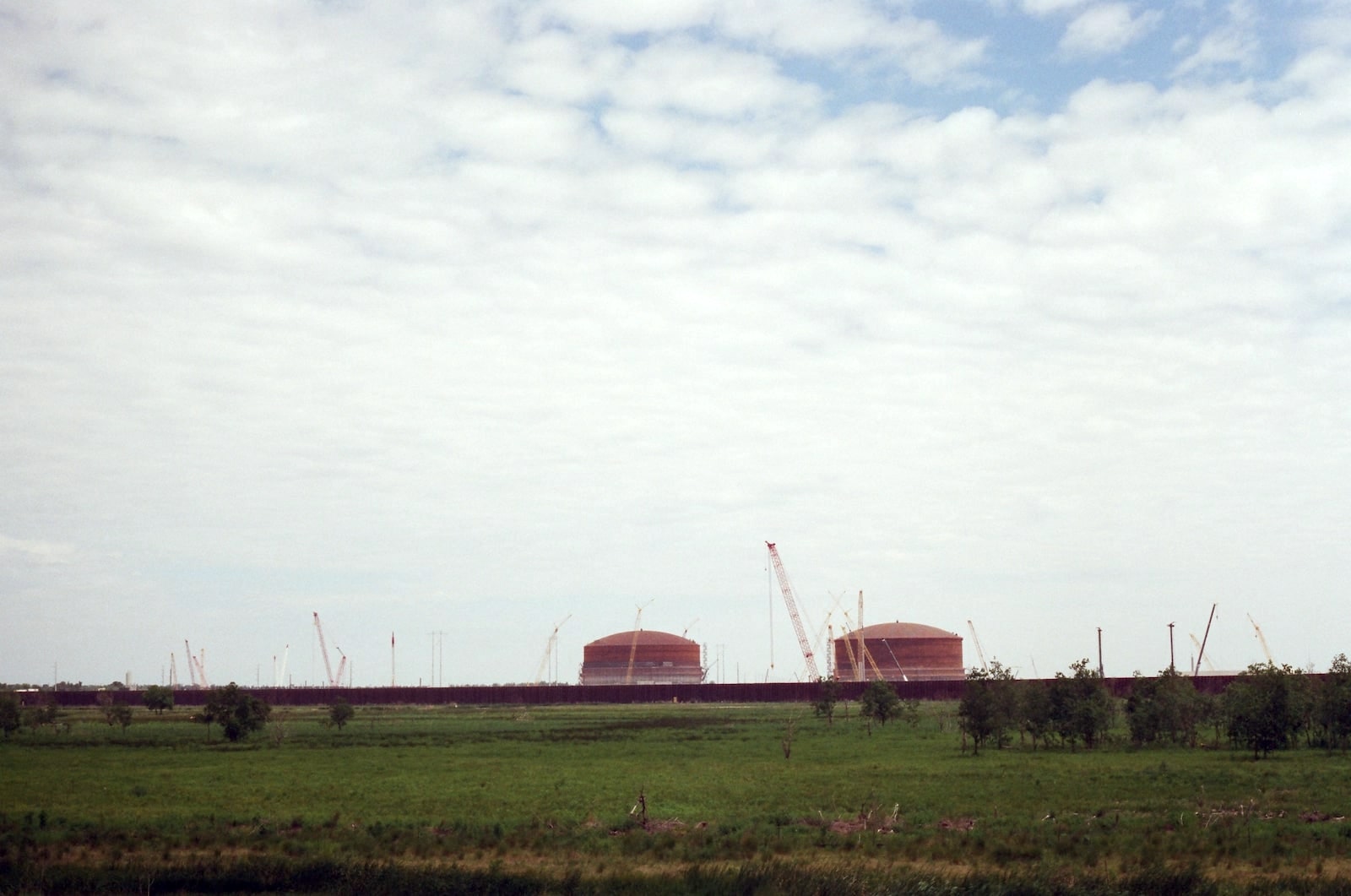
Venture Global’s terminal in Plaquemines Parish will cool natural gas down to its liquid form so it can be loaded onto ships and exported around the world. When the facility becomes operational in 2025, tanker ships will be able to plug into it and offload more than 25 million tons of natural gas each year, enough to power more than 15 million homes over the same period. The opening will represent a triumph for gas drillers that have sought to sell more of their product abroad and for President Joe Biden, who has championed American gas exports to ensure “the reliable supply of global energy” as Europe weans itself off gas imported from Russia following that country’s invasion of Ukraine.
In the 18 months since construction on Plaquemines LNG began, Venture Global has transformed the lives of people who have lived in the 23,000-person parish for generations. The streets around the plant became choked with truck traffic, the marsh threaded with pipelines, and the quiet was replaced with the din of construction. Acres of wetland disappeared beneath concrete. The broad ocean skyline of the parish vanished behind a maze of steel. And Venture Global is already working on another plant in the parish, known as Delta LNG.
“I said it would never happen, then you wake up and here it is,” said Henry McAnespy, a fisherman who grew up in the parish and lives down the road from the project. He described the roar of pipeline workers’ airboats at 6 a.m. each morning and the light pollution from the company’s round-the-clock construction. “I live in a place that never gets dark no more.”
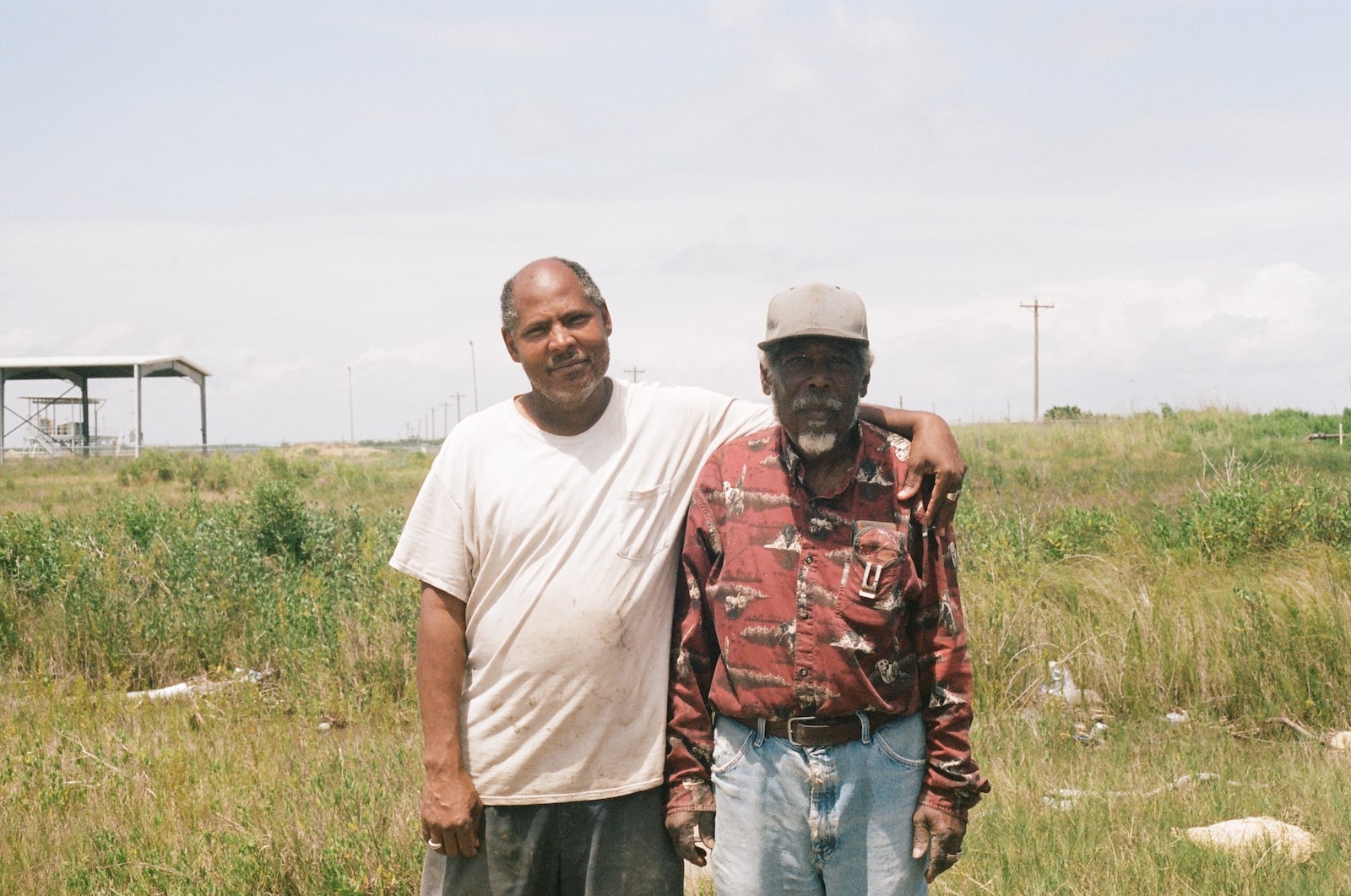
A father and son go shrimping in Calcasieu Lake. Grist / Lylla Younes
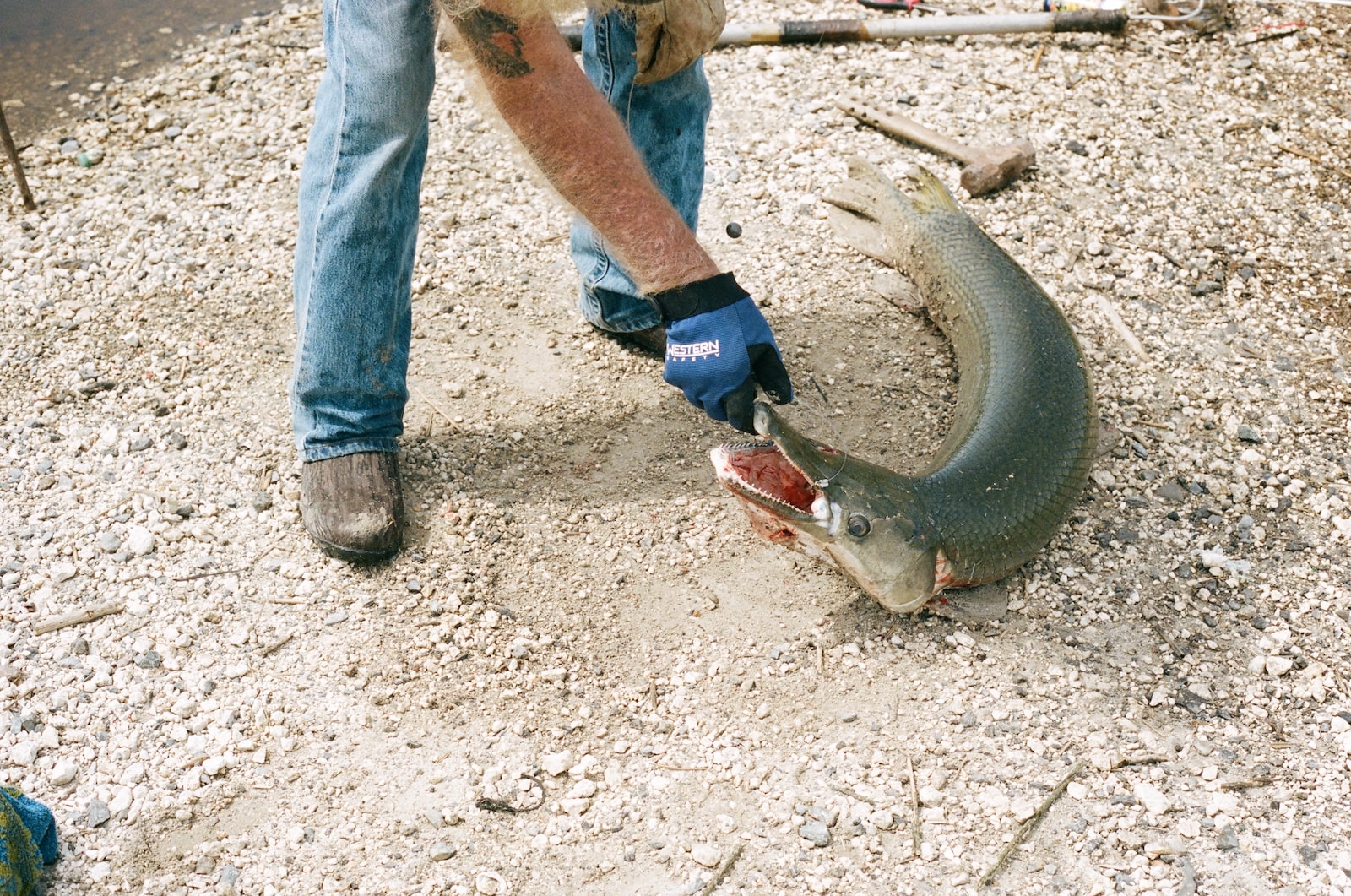
Fishermen hold up an alligator gar, a type of fish native to the Louisiana marsh. New liquefied natural gas plants now threaten those wetlands. Grist / Lylla Younes
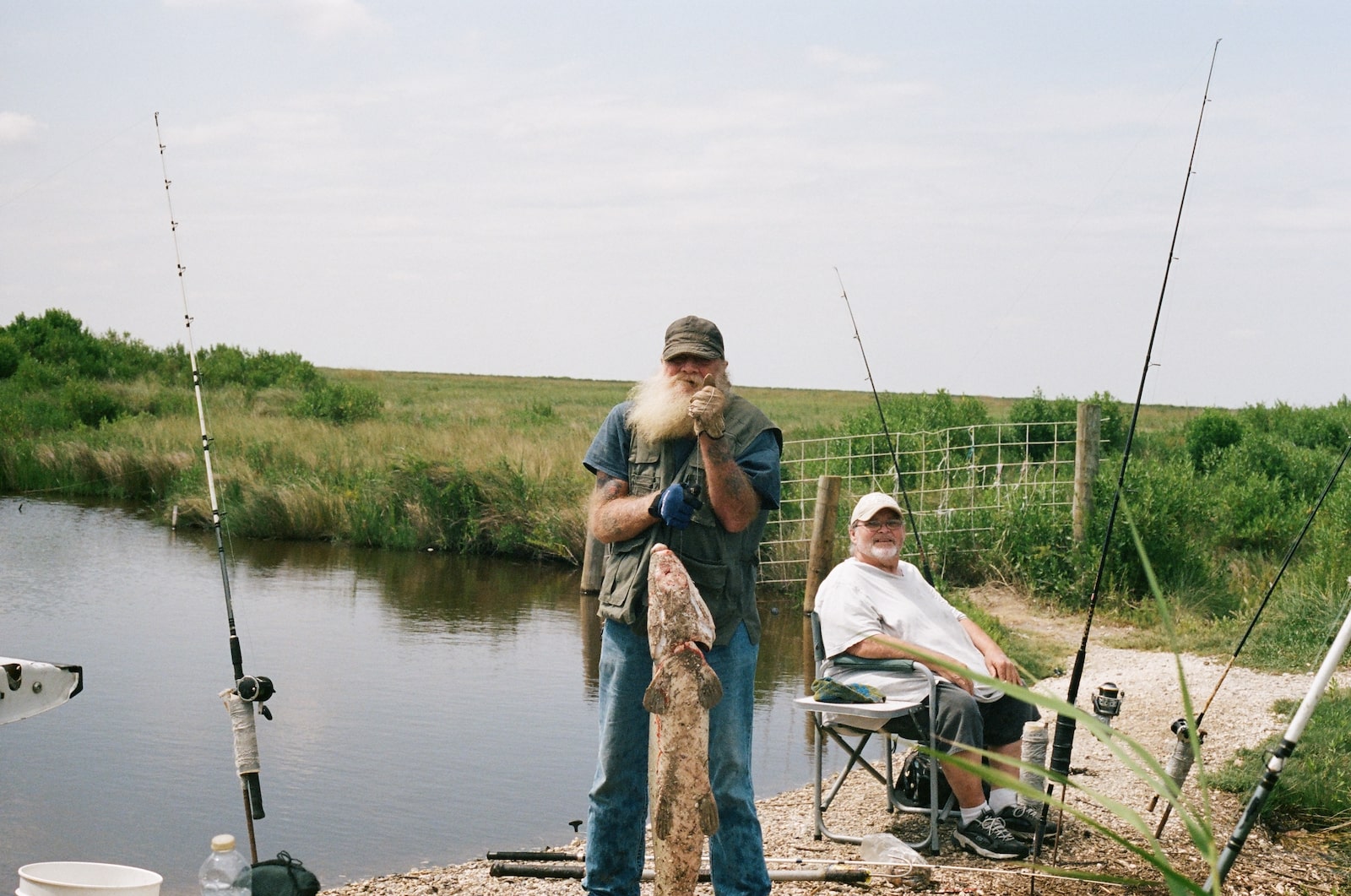
Emboldened by a surge in global demand for natural gas, a small group of companies rushed to build an industry along the Gulf Coast, from the southern tip of Texas to southeastern Louisiana, carving up thousands of acres of vulnerable shoreline to clear the way for massive plants and send American fossil fuels overseas. Liquefaction terminals are among the most complex industrial facilities in existence, with footprints that rival those of the largest chemical plants and oil refineries; the first to open — Cheniere Energy’s plant in southwest Louisiana — encompassed an area the size of nearly 700 football fields.
Building them often requires dredging through shorelines and wetlands to build loading docks and lay hundreds of miles of pipelines. Seven of these facilities have started up in the continental United States in as many years, and at least two dozen more are in various stages of planning and construction along the Gulf Coast. A decade ago, the United States had never exported LNG, but earlier this year it became the world’s top exporter of the fuel, surpassing the gas-rich nation of Qatar.
The growth of the LNG industry in the United States has reordered world markets, offering a new energy source to Europe and Asia even as gas exports drive up domestic energy prices. But it’s on the Gulf Coast, and in particular on the rural fringes of the Louisiana coast, that the consequences of the boom have been most visible. Grist reviewed dozens of state and federal records and found that in their haste to greenlight new terminals, regulators are exposing residents of coastal parishes to new and dangerous sources of air pollution from flares and leaks. Louisiana environmental regulators recently cited numerous violations at Venture Global’s LNG terminal in Cameron Parish, but has allowed the company’s project near McAnespy’s home in Plaquemines, on the other side of the state, to move forward. And as gas exporters build their plants on eroding swampland, they are increasing the risk of catastrophic accidents and explosions during floods and hurricanes. People like McAnespy, who live in neighborhoods surrounding the terminals, are right in the blast zone.
“It’s not just that each of these facilities is like a giant death star on sinking land, it’s that there’s so many of them,” said Elizabeth Calderon, a senior attorney at the environmental nonprofit Earthjustice who has worked on cases challenging LNG terminals in south Louisiana. “This is how sacrifice zones are created.”

When John Allaire bought his 300-acre property along the Gulf of Mexico in the 1990s, the southwest coast of Louisiana was a very different place. There was no industry in sight, just wide expanses of wild grasses and wetlands leading to belts of oak trees, known as cheniers, that lined the sandy shore near the Texas state line. Since then, coastal erosion has wiped away almost all those old growth forests, and much of the landscape has been cleared for the construction of new LNG terminals like the one Venture Global built near the border of his property.
Allaire lives in Cameron Parish, a once sleepy area dotted with fishing hamlets that has transformed over the last decade into one of the world’s most important hubs for exporting natural gas. Three terminals currently operate in the 5,000-person parish; another seven are on the way. If Cameron Parish is where gas companies go to set up shop, carving out pipeline networks and erecting massive liquefaction terminals, then the city of Lake Charles an hour to the north is where they broker business deals. Long a site of petrochemical development and its accompanying pollution, Lake Charles is trying to capitalize off the prime coastal real estate to its south, with local politicians luring gas executives from Germany to Japan with events like the so-called “Americas LNG & Gas Summit & Exhibition,” which they’ve hosted two years in a row at the Golden Nugget Hotel and Casino.
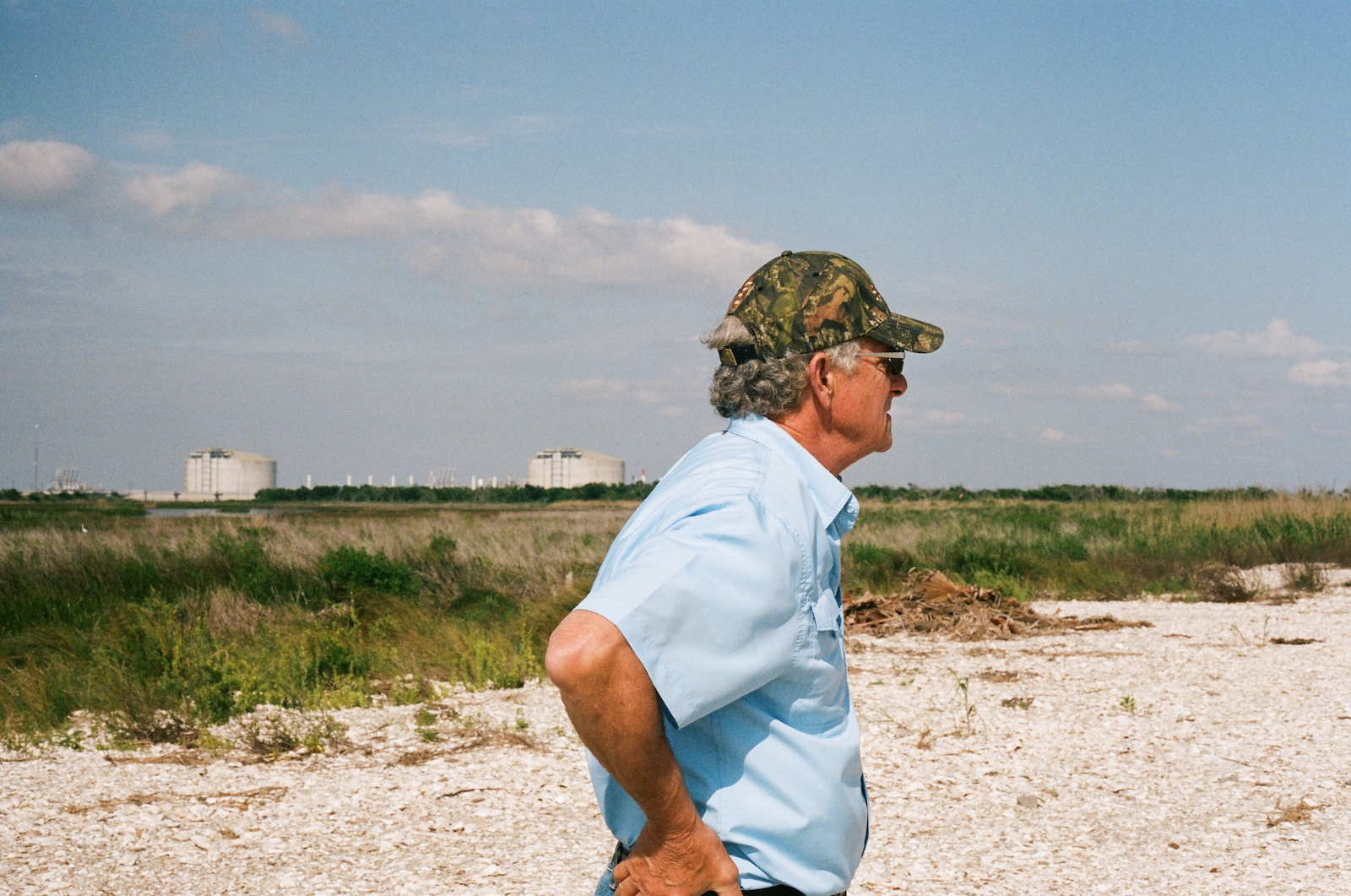
Local officials have celebrated the announcement of every new LNG development in the area, calling the industry a boon for economic growth and employment. Some residents like Allaire have a different perspective. As soon as the Venture Global terminal known as Calcasieu Pass began operating near his home in early 2022, Allaire witnessed a string of problems.
“Right away you had black smoke, alarms going off at the plant, and flares going constantly,” he said.
Liquefying gas is a dirty process. Terminals like Calcasieu Pass operate nearly around the clock, sucking in gas from a national network of pipelines and liquefying it so it can be loaded onto ships. When there’s too much gas backed up in the pipes, or when other refrigerant chemicals start to build up, the company prevents explosions by burning off gas, which sends orange flames shooting into the sky from the company’s flare towers.
As a former oil and gas engineer, Allaire knows that a certain level of flaring is to be expected when workers attempt to control pressure variations within their equipment, but too much flaring can be a sign of larger problems. Flaring releases a cocktail of pollutants like carbon monoxide, black carbon, and volatile organic compounds like benzene and formaldehyde. These chemicals are especially dangerous for vulnerable people like pregnant women, whose odds of having a premature birth can double from regular exposure to pollution from flares.
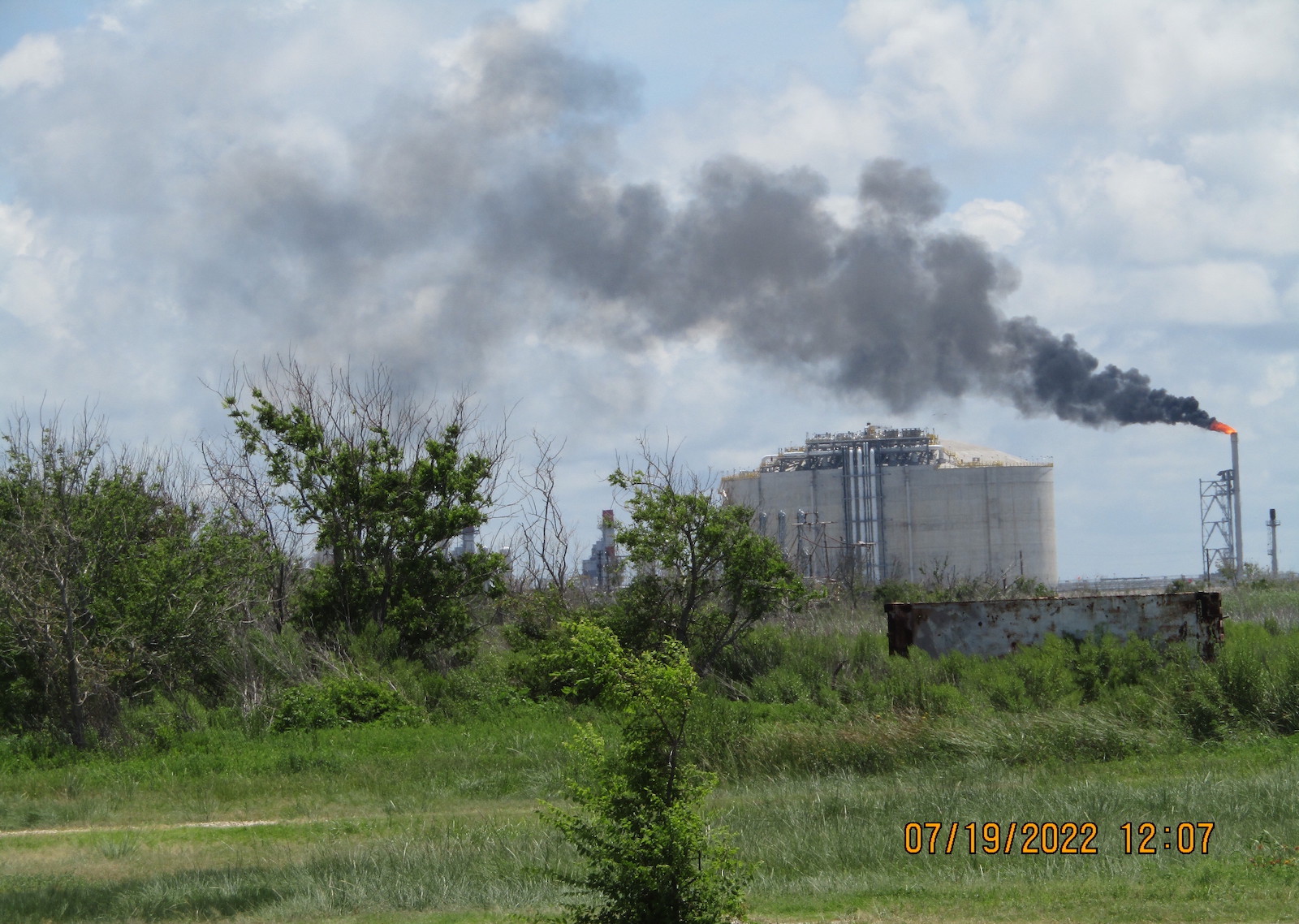
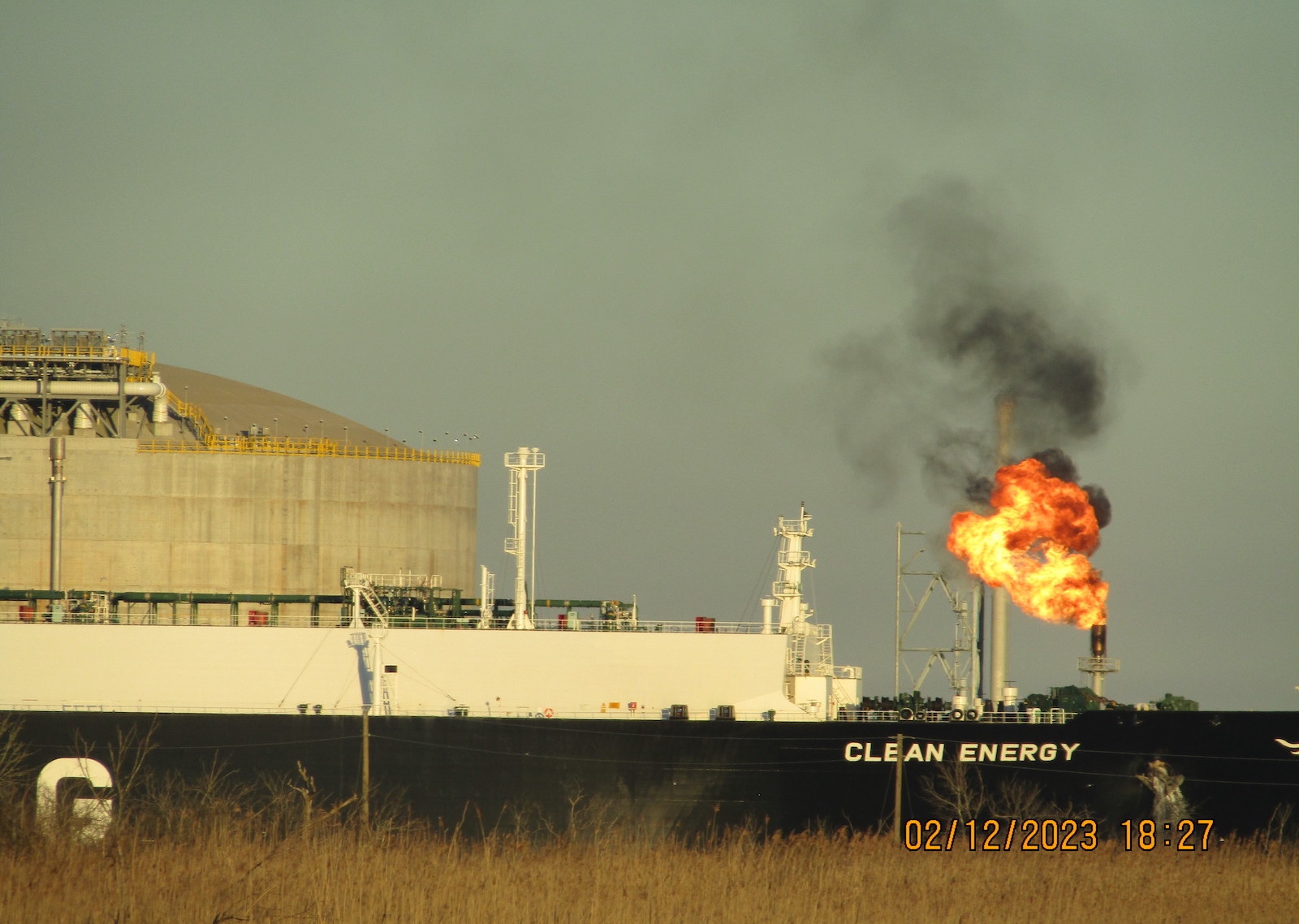
Soon after Calcasieu Pass was up and running last year, Allaire began photographing the flares, which often burned throughout the day and into the night. His kitchen table is now littered with printouts of these timestamped images, which, added together, reveal the frequency of the plant’s mishaps. A report by the Louisiana Bucket Brigade, an environmental nonprofit, found that the facility violated the Clean Air Act by exceeding the pollution thresholds specified in its permit more than 2,000 times last year, according to the facility’s own records reviewed by Grist. This flaring led to the release of numerous chemicals, including between 19,000 and 37,000 pounds of nitrogen dioxide, a greenhouse gas that has been linked to chronic lung disease.
Despite these violations at Venture Global’s first terminal in the state, the Louisiana Department of Environmental Quality has signed off on the construction of Venture Global’s second facility in Plaquemines Parish, which the company itself describes as “technologically identical” to the first one near Allaire’s home in southwest Louisiana.
“Talk about an experiment,” Calderon of Earthjustice said of Venture Global’s two newest enterprises. “They want to be allowed to emit air pollution at the levels of their failed engineering rather than at the levels they promised.”
Last month, in a rare move, the same state agency issued a compliance order against Venture Global for “preventable” and “unauthorized” violations at Calcasieu Pass. In the order, regulators detailed the company’s “failure to timely report” its emissions and alleged that it misrepresented the extent to which its equipment had malfunctioned.

Neither the Louisiana Department of Environmental Quality nor Venture Global responded to multiple requests for comment on the company’s permit violations or any other details in this story. In a written response to the department, Venture Global’s lawyers said they will likely dispute certain portions of the order.
Flaring is just one of multiple ways that LNG terminals release toxic chemicals into their surroundings. Supercooling natural gas until it becomes a liquid at minus 260 degrees Fahrenheit relies on engines known as turbines that burn fuel to produce massive amounts of electricity. The turbines at Calcasieu Pass near Allaire’s house have a generation capacity of 720 megawatts, enough to power more than 500,000 homes at once.
The Environmental Protection Agency considers gas turbines major sources of toxic air pollution, since the combustion process releases a slew of cancer-causing chemicals such as benzene and formaldehyde. That pollution can travel dozens of miles away, diminishing air quality in more densely populated inland areas like Lake Charles. What’s more, enforcement records from the Louisiana Department of Environmental Quality indicate that these machines are prone to malfunctions, sometimes for long stretches of time. Last year, three gas turbines at Calcasieu Pass failed repeatedly over two straight months, emitting thousands of pounds of pollutants into the air.
Emissions from LNG terminals across Louisiana and Texas are putting an outsize burden on lower-income neighborhoods. In Cameron Parish where Allaire lives, the median income is $64,000, but more than 14 percent of people are below the federal poverty line, $30,000 for a family of four. A federal analysis of the Venture Global plant in Plaquemines found that two-thirds of residents in a census block near the terminal live below the poverty line.
Advocates see the LNG buildout as part of a larger industrial expansion that has also disproportionately affected Black people. The cluster of terminals in Cameron Parish is just south of Lake Charles, where nearly half of all residents are Black. There, emissions from LNG terminals are compounded by already high pollution levels drifting in from the nearby town of Westlake, where a maze of chemical complexes emits thousands of pounds of cancer-causing chemicals such as vinyl chloride and 1,3-butadiene every year, causing the air to smell like burnt plastic.
“Our children are dying from asthma,” said Roishetta Sibley Ozane, an activist from Lake Charles who runs the Vessel Project of Louisiana, a local environmental organization. “People have cancer. And yet these industries are allowed to pollute and emit all of this right in our community and nothing is being done about it because it’s going under the radar.”
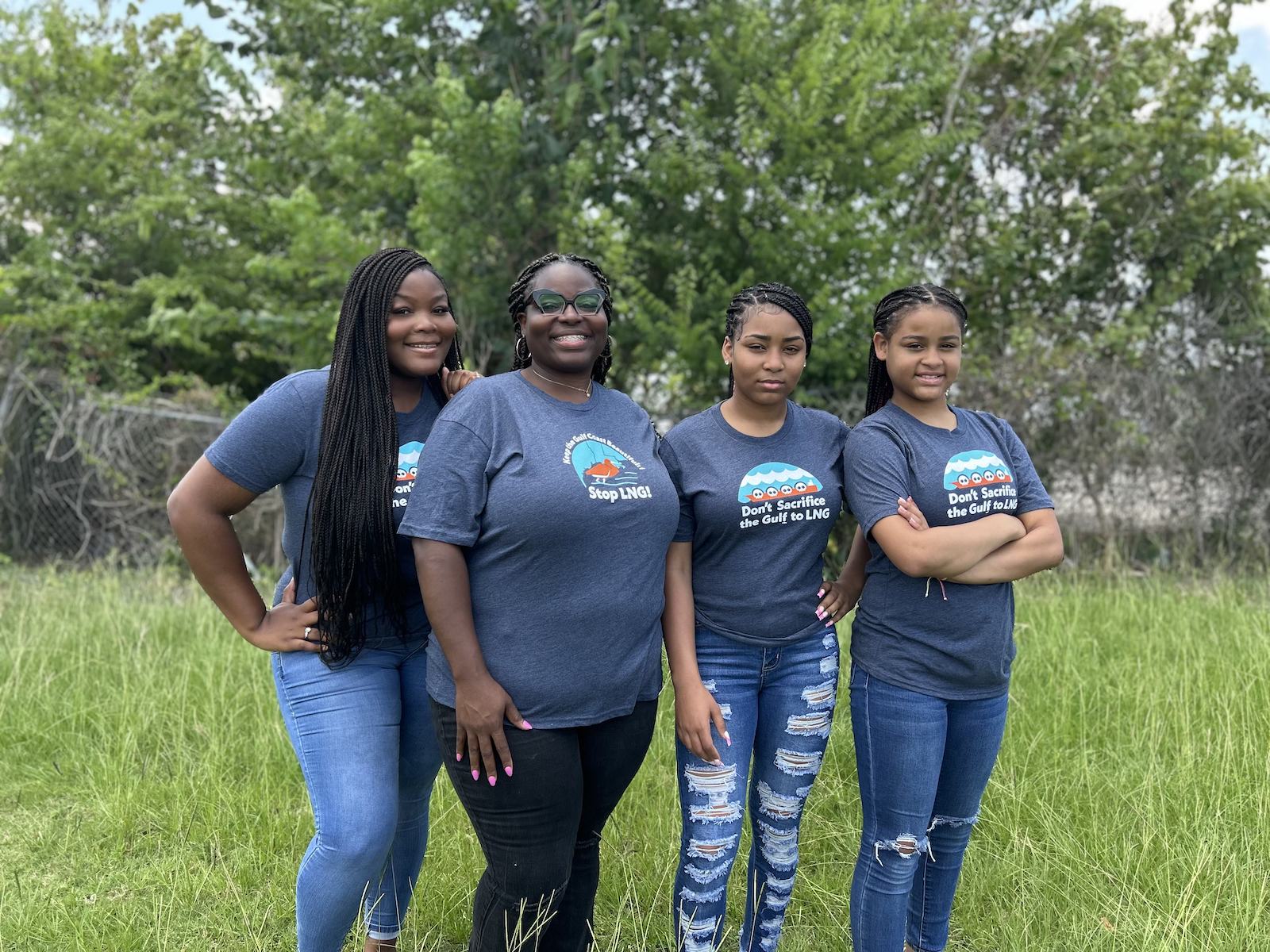
In a petition sent to the EPA in late May, seven environmental organizations from the Gulf Coast, including Ozane’s, alleged that regulators in Louisiana and Texas are illegally granting permits to oil and gas companies, including LNG operators such as Venture Global. The petition charged that in giving them permits to build new infrastructure without first requiring them to demonstrate through modeling that their facilities will be in compliance with the law, Louisiana has violated the federal Clean Air Act, which prohibits granting a company a permit that will “cause or contribute” to a violation of federal air quality standards. The organizations sent a separate civil rights complaint to the agency in June, arguing that allowing the industrial buildout discriminates against majority-Black communities in Louisiana like Lake Charles.
Regulators in Louisiana and Texas declined to comment on the petition, and the EPA told Grist that it would not comment on an open civil rights complaint.
Allaire said that he plans to continue documenting Venture Global’s flares, and he worried aloud about a new fight on the horizon. Another company, Houston-based Commonwealth LNG, is about to break ground on an export terminal and pipeline network just over his property line. In 2021, Allaire turned away representatives from Commonwealth who offered to buy his land. He said that he refuses to leave, no matter the offer.
“This is a unique spot, all my kids grew up here,” Allaire said, gazing out his truck’s windshield at the bright green widgeon grass floating on the surface of his pond. “They grew up hunting and fishing and stargazing and campfiring. … It’s not for sale.”
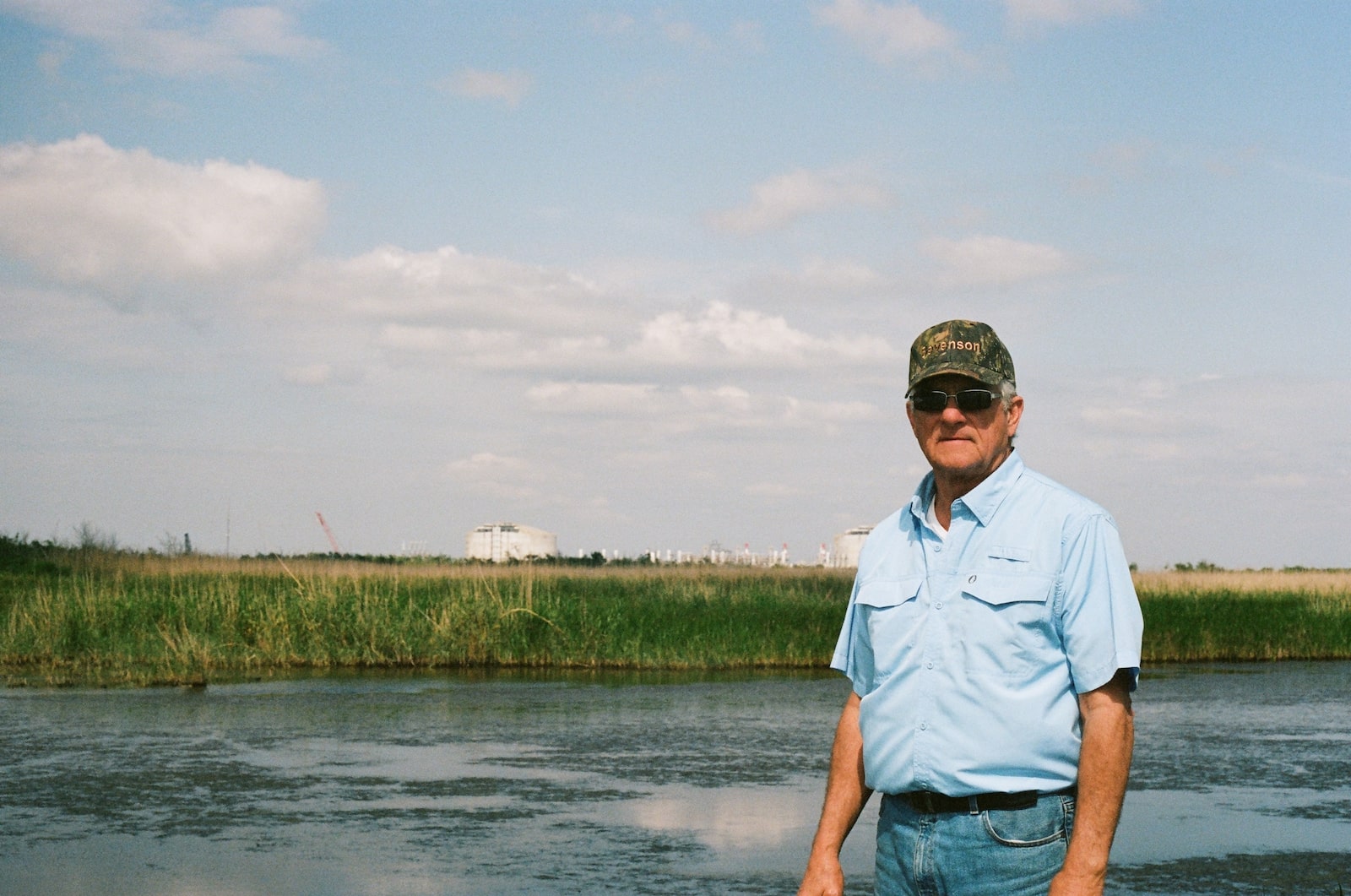
John Allaire stands on his property in Cameron Parish. Grist / Lylla Younes
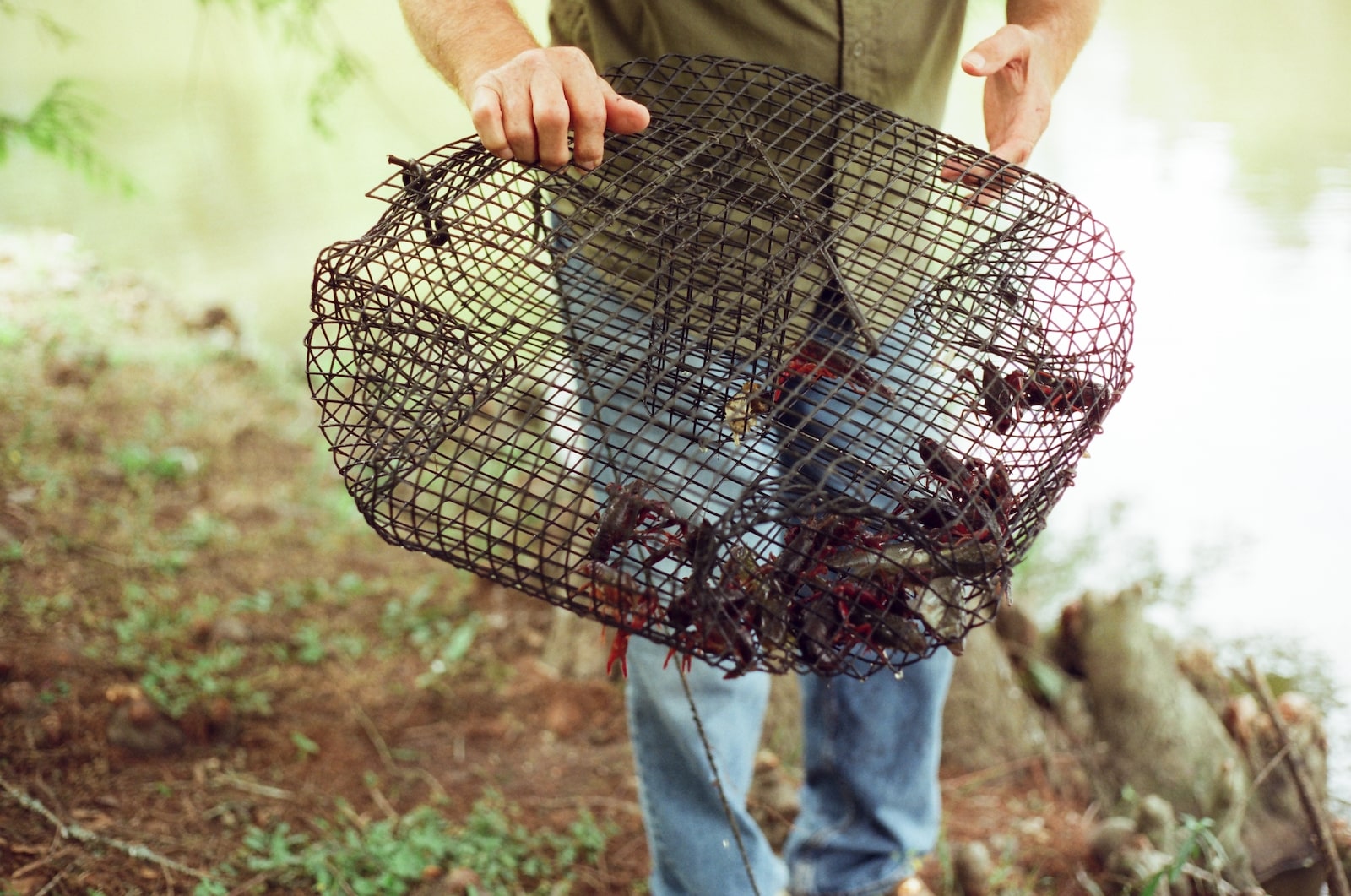
An alligator glides through the water in Plaquemines Parish. Nearby, a fisherman traps crawdads. Grist / Lylla Younes
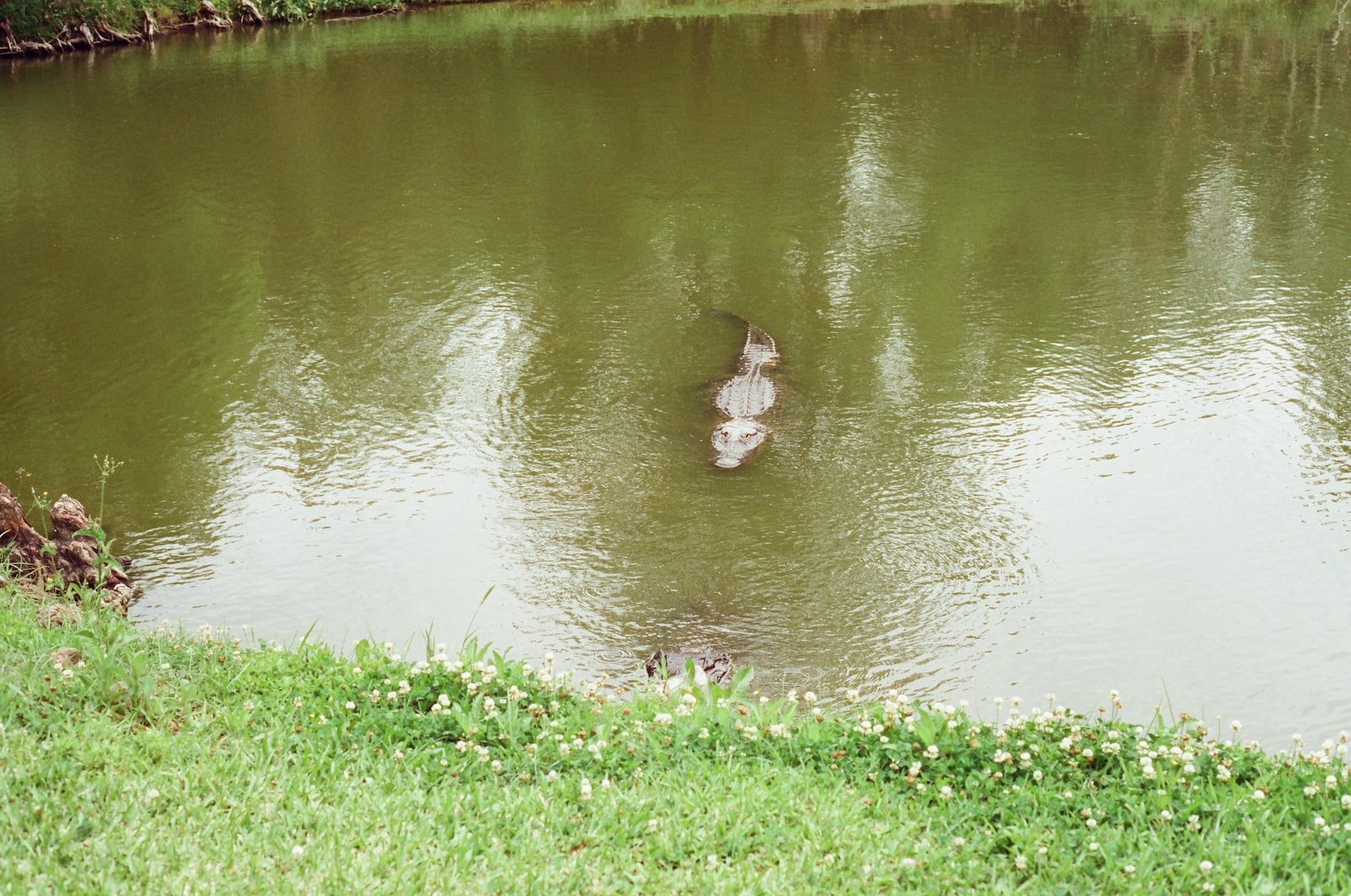
Allaire said that after 40 years working in the oil and gas industry, the year and a half that he’s spent living near an LNG terminal has changed his mind about a few things. When he worked at an oil refinery in the 1980s and 1990s, he wasn’t aware that burning all that fuel would cause carbon to build up in the atmosphere, but now he’s certain about the industry’s impact on the climate. Though natural gas is a less carbon-intensive fuel than oil, burning it for electricity still releases carbon dioxide, and drilling for it can also cause significant leaks of methane, a potent greenhouse gas. Yet the companies building LNG terminals in Cameron Parish are assuming that international demand for the fuel will be robust for decades to come.
“They’re selling it abroad to the highest bidder” with full knowledge of what it’s doing to the planet, Allaire said. He now sees oil as a finite resource, bound to dry up eventually, and believes that the country is going to have to switch to renewables at some point.
“It’s just a question of when,” Allaire said. “How much carbon do we put in the atmosphere hoping that it won’t have catastrophic effects?”
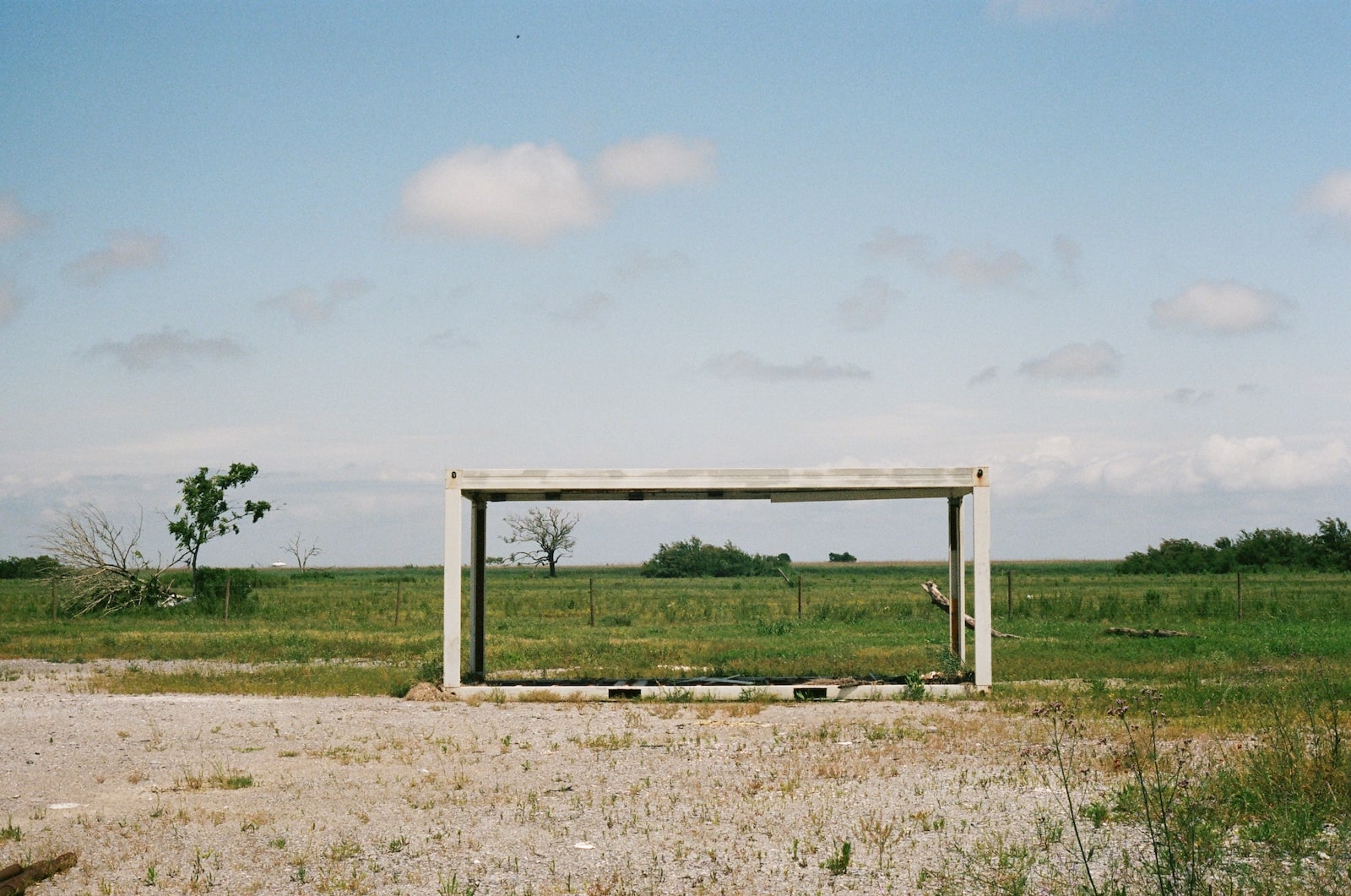
Since Venture Global began constructing its first gas hub in Plaquemines Parish in 2022, Henry McAnespy’s life has changed in numerous ways. A commercial fisherman since high school, the 64-year-old laments the way the company dredged the marsh where he goes fishing to lay 36-inch-wide pipelines. The water pressure in his home, already low after Hurricane Ida damaged the parish’s water system two years ago, is even weaker now; McAnespy and other locals think it’s tied to the company using the limited resource to build its terminal.
But the thing that keeps him up at night is the fear that, at any moment, Venture Global’s mile-wide terminal up the road could explode.
“You don’t have a crystal ball, you can’t tell me what’s going to happen to this plant,” McAnespy said. “I don’t want to live by this and I don’t think any investor would move his family here either.”
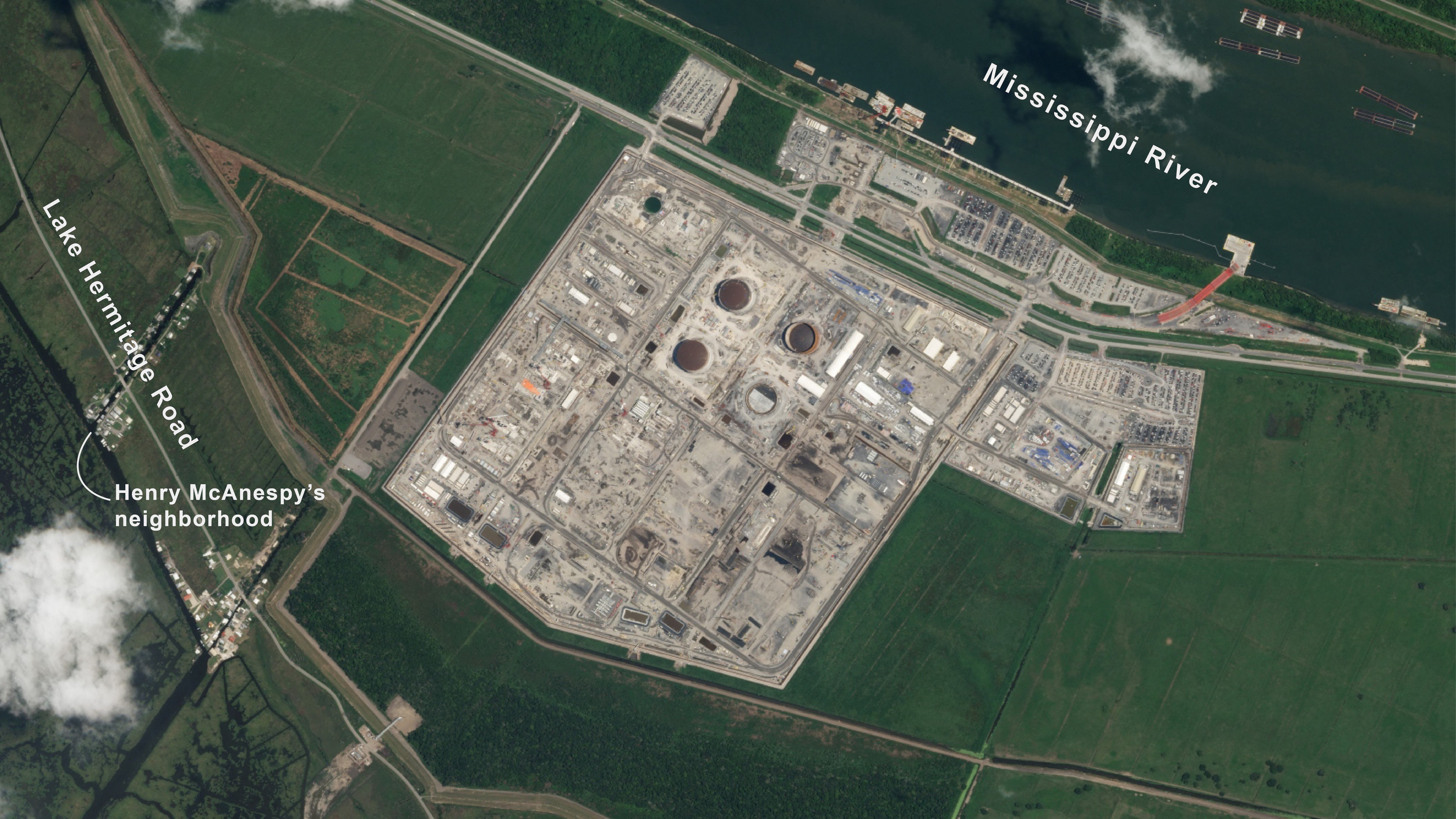
Of the five liquefied natural gas terminals in operation on the Gulf Coast, at least four have suffered some kind of leak or blast, whether due to extreme weather or a mechanical malfunction. Multiple incidents at LNG facilities on the Gulf have already demonstrated what happens when supercooled gas escapes from pipelines and storage tanks, underscoring the potential for damage like the kind McAnespy fears.
In early 2018, liquefied gas escaped through a crack in one of the storage tanks at a facility in Cameron Parish owned by Cheniere Energy, a Houston-based corporation that was the first American firm to export LNG. Workers discovered and patched the leak before any explosion occurred, but an investigation by the Pipeline and Hazardous Materials Safety Administration, part of the federal Department of Transportation, revealed other cracks in the tank. The regulator fined Cheniere $2.2 million and ordered the company to stop using two faulty tanks, deeming them “hazardous to life, property, or the environment.”
A year later, during a separate, previously unreported incident at the same facility, a leak of an unidentified substance caused three construction workers to lose consciousness, according to a lawsuit filed by the workers against Cheniere in Texas state court. The three workers were on the job near one of the plant’s giant liquefaction machines when they became “overwhelmed with the odor of gas.”
In an incident report provided to the court, one of the workers recalled that he “started to feel weak and [dizzy]” after smelling a “strong odor of unknown chemicals,” and after that he “didn’t remember anything until [he] arrived at the Port Arthur hospital.” Cheniere said it couldn’t figure out the source of the leak, according to court documents, calling its investigation “inconclusive.” (A judge ruled in Cheniere’s favor on procedural grounds last year, but the workers have since filed for a new trial.)
Leaks and malfunctions like these can also trigger explosions. In June 2022, a thunderous blast shook Freeport LNG’s facility in Freeport, Texas, the second-largest export terminal on the Gulf Coast, rattling the town of 10,000. A malfunction in one of the plant’s pressure valves caused gas to back up in a pipeline and leak out into the air, where it formed a dense “vapor cloud” and then ignited. It took eight months for Freeport LNG to repair the damage from the blast and secure permission from the federal government to export gas again.
It hasn’t happened on the Gulf Coast yet, but experts worry that the liquefaction process could lead to much bigger blasts. The Freeport explosion involved a leak of methane, but export terminals also employ a cocktail of chemicals known as refrigerants to condense gas into a liquid, including ethylene, propane, and hexane. They are all even more explosive than gas itself, which means they would cause larger vapor cloud explosions, perhaps large enough to level entire city blocks.
“We have searched high and low to find this answer of how far people would be affected and no one has been able to tell us,” said Naomi Yoder, a staff scientist at the Gulf Coast-based environmental organization Healthy Gulf who studies LNG terminals. “If they don’t have those answers, then what in the world are we doing building these things?”
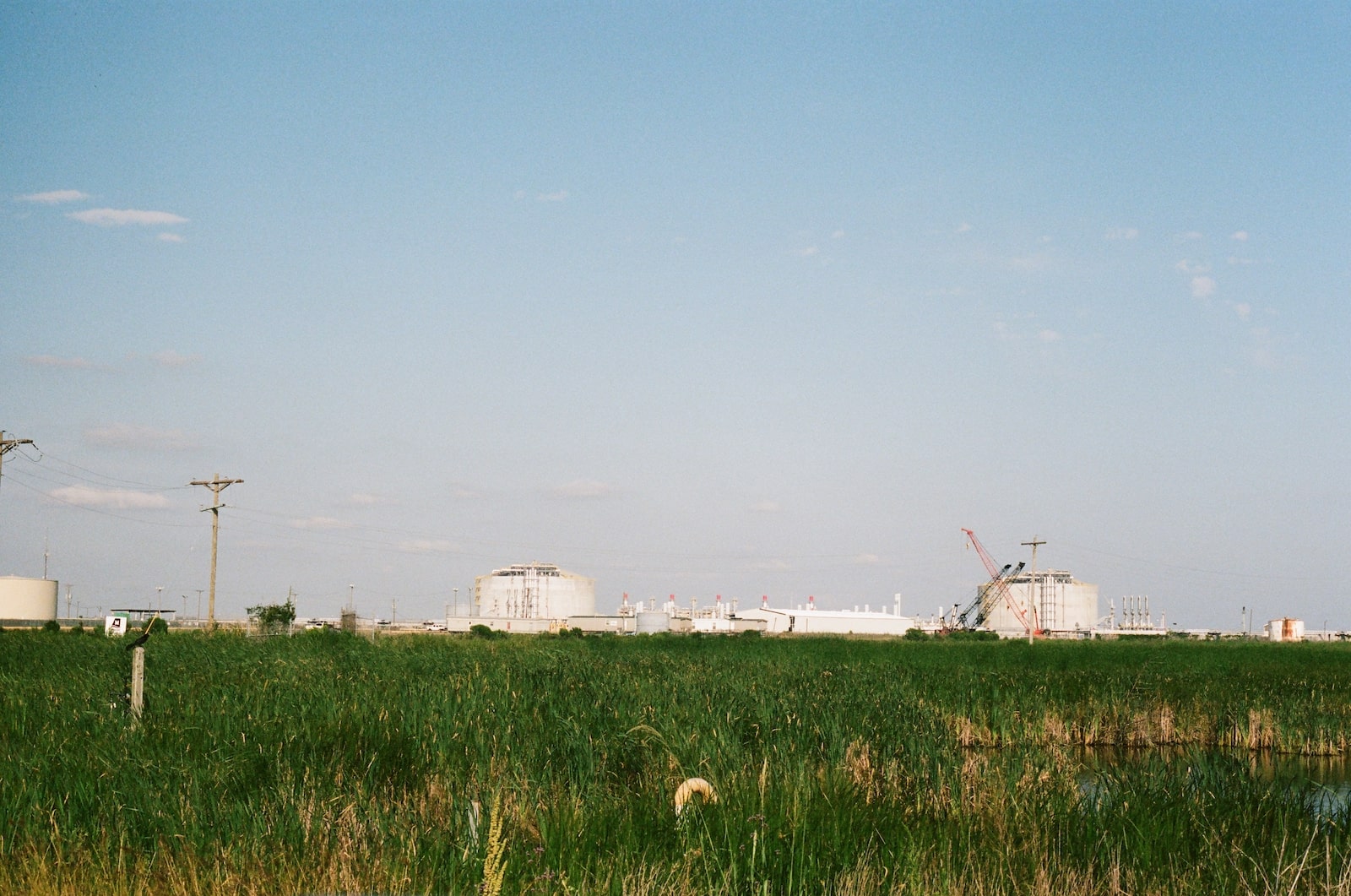
Venture Global and other gas exporters have promised jobs in cash-strapped parishes that sometimes fail to provide residents with basic services. Officials in Cameron, for instance, are still working to resume medical treatment at the parish’s only hospital, which was damaged by Hurricane Laura in 2020. And in July, Louisiana’s Governor John Bel Edwards, a Democrat, declared a state of emergency in Plaquemines after saltwater from the Mississippi River began seeping into the drinking water supply. In response, the parish and a state agency handed out 200,000 bottles of water.
Some locals are worried that the new terminals won’t improve these conditions even if they deliver on the promise of more jobs. Supporters of the Plaquemines project say the parish badly needs the 250 jobs and 728 indirect jobs that Venture Global promised to create, since almost the same number of positions were eliminated when the Phillips 66 Alliance Refinery up the road shuttered in 2021. In an effort to lure the company to the parish in 2016, the Louisiana Board of Commerce and Industry awarded Venture Global a 10-year property tax break to build the LNG terminal. That break was worth $83.5 million in the first year of the contract, a sum larger than the parish’s 2022 budget of $75 million. The board recently approved another $29.8 million in payroll tax rebates to the company over 10 years.
McAnespy appreciates the economic benefit of the terminals, but says companies like Venture Global often ignore the residents who live closest to the facilities.
“The plant is a wonderful economic boost, not just to Plaquemines or the state of Louisiana, but worldwide,” McAnespy said. “My concern is that it’s such a big project that they’re imposing their will on us. Have a little respect for us.”
Given the chance, McAnespy said, he’d move 10 miles up the road and away from the plant where he would be more confident that his family could easily evacuate if there was an explosion. McAnespy’s house is likely within the blast radius of the plant’s high-powered liquefaction machines, as well as its massive gas storage tanks.
McAnespy said that Venture Global offered to buy the houses of some people living on the east side of Lake Hermitage Road in Plaquemines Parish, which the company considers to be the outer boundary of its blast radius. But people like him just across the street haven’t heard anything from the company.
“I feel like they should come back here and give me an option to buy me out,” he said. “Do your project, just give me fair market value for my property. I’ll pick up my pieces and go live somewhere else.”
On a bright day in April, Travis Dardar stood with his boot heels in the shallows of Calcasieu Lake, a few miles away from John Allaire’s house, surveying the area where he took his boat out to catch shrimp each spring. The 38-year-old Dardar has been fishing all his life, beginning in his hometown of Isle de Jean Charles, an island community in southeast Louisiana.
“Back then, fishing wasn’t really a choice for me, you know?” Dardar said, eyes shaded under his camo Louisiana State University baseball cap. “It was the kind of lifestyle we grew up in. We had to eat.”

Like other residents of Isle de Jean Charles, Dardar is a member of the United Houma Nation, a state-recognized tribe, and his family had a strong connection to the island. He rebuilt his family home there twice after successive hurricanes ripped through. But after many of his neighbors moved away and his grandfather died, the place didn’t feel like home anymore. Other residents of Isle de Jean Charles were taking part in one of one of the first climate resettlement programs in U.S. history, and Dardar decided it was time for him to leave, too. In 2015, he and his wife and kids moved west to Cameron, where he could still make a living by shrimping, the only way he’d ever known.
Dardar quickly got used to life in Cameron, a fishing community just like Isle de Jean Charles. But then came the LNG terminals, one after the other, tearing out patches of wetlands larger than football stadiums and changing the chemistry of the air and water. The export facilities now ring Calcasieu Lake, a gourd-shaped body of water separated from the Gulf of Mexico by a narrow channel that cuts through a stretch of wetlands. Until recently, most of Louisiana’s largest fossil fuel facilities sat well inland from the Gulf. Sitting back from the water gave oil refineries and chemical plants protection from storm surges and easy access to highways and pipelines. LNG export terminals are different: Because they load gas right onto massive tanker ships, these facilities must sit right at the water’s edge, on land that is both undeveloped and especially vulnerable to flooding.
That soon became a problem for people, like Dardar, who caught shrimp on Calcasieu Lake for a living. The massive waves created by gas tankers damaged his boat and forced Dardar and his fellow shrimpers to cluster in a corner of the lake where they all vied for a small share of the catch. Another gas company, Tellurian, had announced plans to open a 1,200-acre terminal on the Calcasieu River, which empties into the lake, and they began to worry that the shipping traffic to that terminal would one day push them out for good.
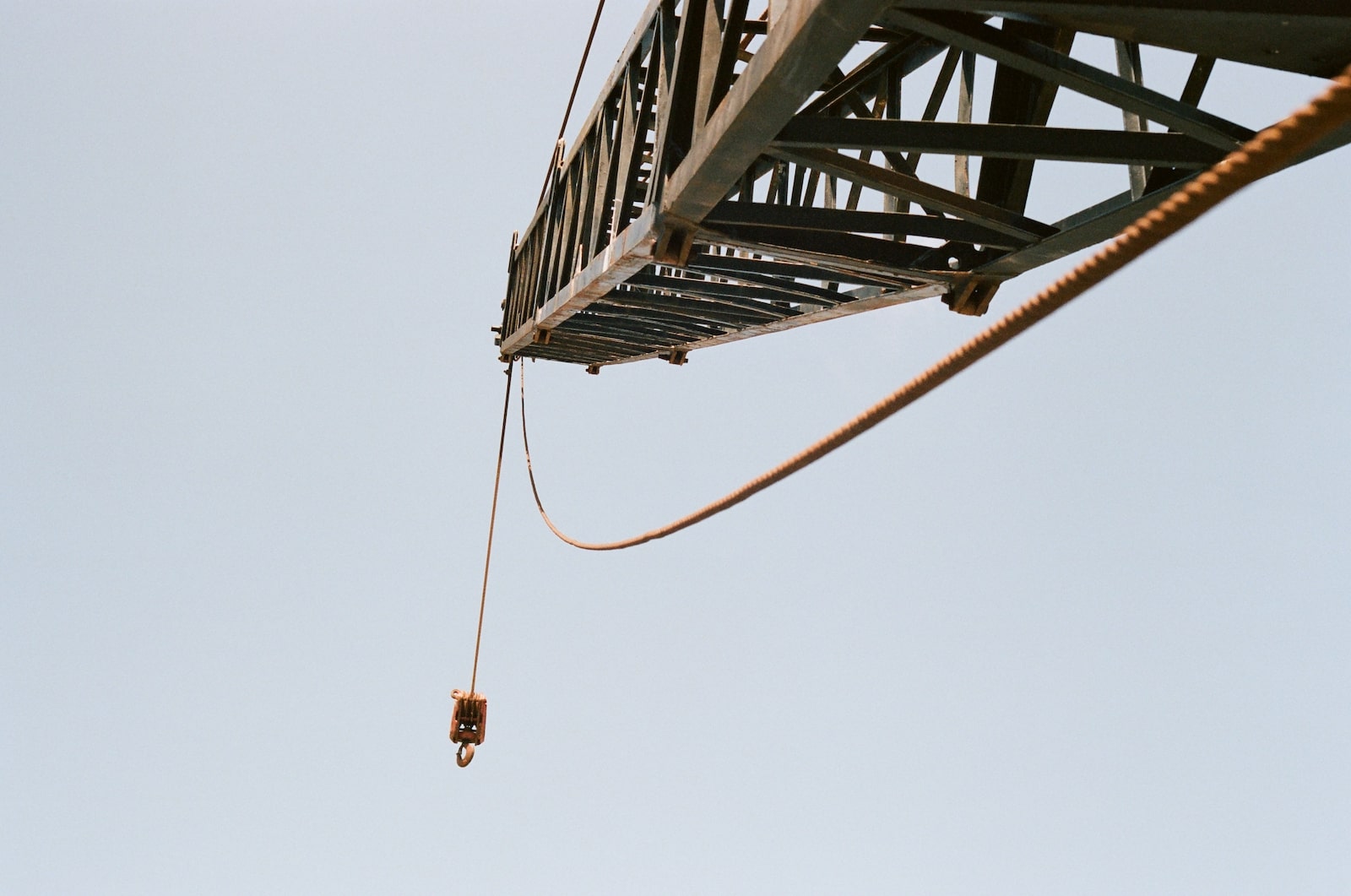
To Dardar, it seemed like a sort of cosmic joke. He’d survived decades of deadly hurricanes only to leave Isle de Jean Charles, and when he finally achieved some measure of stability, a new industry rose up around him, an outside force challenging his livelihood once again. In fact, the plants came to Cameron for the same reason Dardar did: Calcasieu Lake is an ideal access point for LNG tankers coming in from the Gulf of Mexico.
This summer, Dardar made a choice he’d fought hard to avoid. He took a buyout from Venture Global and used the money to move his family 20 minutes north to the town of Kaplan, where he could continue shrimping in nearby Intracoastal City. Dardar said that in the month since they moved, he sleeps better at night. The air, too, is easier to breathe.
“Kind of feel like we’re at home,” Dardar said of the new property in Kaplan. He described the final months in Cameron as eerily similar to the end of his time on Isle de Jean Charles.
The rapid expansion of the LNG industry in Cameron Parish might have pushed Dardar away from the coastline, but Venture Global and its fellow LNG exporters are incurring their own risks by setting up along the Gulf Coast. The five active LNG terminals bordering the Gulf of Mexico sit at the end of “Hurricane Alley,” a band of warm water that begins off the northwest coast of Africa and stretches across the Atlantic, providing fuel in the form of heat for dangerous hurricanes to form.
In August 2020, Hurricane Laura made landfall in Cameron Parish, driving a 17-foot wall of water onto southwest Louisiana’s coast and exacting damage on a third of the state’s industrial facilities, including multiple LNG terminals. A pressure system failure at Cheniere’s facility led to the release of more than 100 tons of pollutants, and a nearby plant owned by San Diego-based Sempra Energy reportedly flared for days after the storm. Two months later, Hurricane Delta swept through, causing more damage to petrochemical plants across the state.
“These locations can barely handle storms now,” said Jessi Parfait, a native of south Louisiana who works on the Sierra Club’s Beyond Fossil Fuels campaign. “Just imagine 30 years into the future, which is supposed to be the lifetime of these facilities, potentially more. They’re not going to be as protected.”
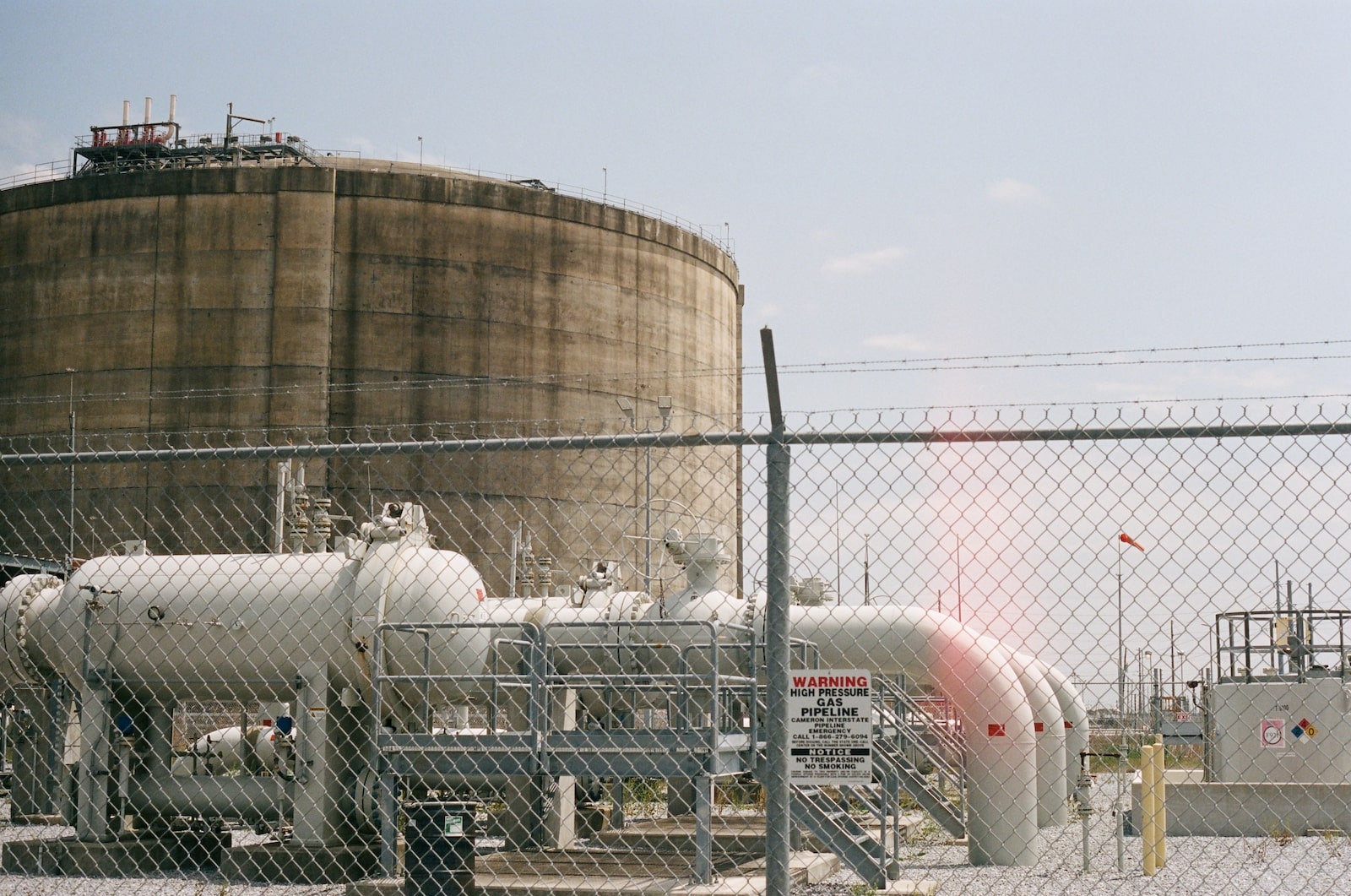
LNG developers have tried to assure investors and regulators that they’re getting ahead of future hurricanes by weather-proofing their facilities. A representative from Commonwealth LNG, the firm planning to break ground next door to Allaire’s property in Cameron, told Grist that it will build a “storm-surge wall intended to minimize flood damage or disruption of operations.” A representative from Sempra Energy pointed out that its facility is located 18 miles inland and eight feet above sea level, which puts it out of reach of storm surge events. The representative noted that the terminal suffered minimal damage when Hurricane Laura hit in 2020.
But the risks are only increasing. The sea levels off the coast of Louisiana are likely to rise by as much as two feet over the next 30 years, and the waters of the Gulf of Mexico are only getting warmer, which will provide more fuel to hurricanes as they make landfall. By the end of the century, the Gulf Coast region might be as much as 12 degrees F hotter, which will allow rainstorms to hold more moisture.
Last year, the Sierra Club asked Ivor van Heerden, a noted marine scientist and former Louisiana State University professor, to assess the hurricane risk of Venture Global’s Plaquemines LNG terminal. Van Heerden is perhaps best known for predicting the potential devastation of Hurricane Katrina more than a decade before the storm submerged New Orleans in 2005.
When completed, Plaquemines LNG will be surrounded by a 26-foot storm wall and flanked by two separate levee systems. In his report, however, van Heerden determined that a Category 4 or 5 hurricane like Laura or Ida could still flood the facility and cause widespread damage that would spill into surrounding wetlands and nearby communities.
“It is my opinion after years of studying hurricanes and flooding that this LNG site will be flooded, in the not-too-distant future and perhaps even the next hurricane season,” van Heerden wrote in the report. If a flood ever breached the plant’s levee system, he wrote, there would be a high probability of chemicals “being carried off the site and into homes, businesses, farmland, and fragile coastal wetlands.”
The risks are similar at the five other LNG facilities that now line the Gulf Coast, and future export terminals in Louisiana and Texas will be just as prone to devastation during storms. As van Heerden sees it, the gas industry is on a collision course with rising sea levels and ocean temperatures, building explosive infrastructure in an area that is only getting more vulnerable to climate change.

Grist sent questions about air pollution and hurricane risk to all five companies that operate LNG export terminals in Texas and Louisiana, and only two responded. A representative from Sempra Energy, said that the company “put[s] the health, safety and security of our workforce, customers and communities at the center of everything we do.” A representative from Commonwealth LNG said that “the safety of our employees, the public, and the environment … have the highest priority in everything that we do.”
Officials in Louisiana ignored van Heerden’s warnings before Katrina, and the result was the most expensive natural disaster in the history of the United States, costing more than $170 billion. If he’s right about the risks of exporting LNG, coastal Louisiana could see a devastating LNG disaster in the coming years, as soon as the right hurricane strikes, and it will be people like Henry McAnespy who bear the immediate damage from chemical explosions and contamination. The effects would also be felt well beyond coastal Louisiana.
“The average American should recognize that when it all goes to hell in a bucket, they’re the ones who are going to be coughing up the money for the remediation,” van Heerden told Grist. “Katrina cost billions of dollars. The cost [of an LNG disaster] is going to be borne by the American public, and it’s going to be a substantial cost.”
Editor’s note: Earthjustice and the Sierra Club are advertisers with Grist. Advertisers have no role in Grist’s editorial decisions.
